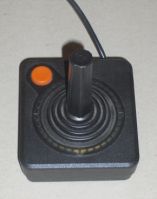Game progression in the ol' days
How sense of game progression was achieved in old games? How the physics term hipercolation threshold relates with the classic Snake game?

If we examine how games were crafted in the early 80’s, we can observe a common element they shared. That’s game progression.
The player was never notified about the game mechanics. It was on his own to discover how controls worked, the same for the goal of the game.
As keypads and joysticks on first consoles like the Atari VCS 2600 only had one button and a stick or d-pad for directional movement, it was quite easy to grasp the controls of any game. The in-game goal also became apparent very quickly because the action happened always in one single screen (except in games like Pitfall that simulated scroll attaching static screens).

AtariJoystick
Console pads and joysticks went from one button…

6button pad
… to unmanageable ones with many buttons
The interface only told the player his score and number of lives, there were no tutorials, nor text feedback when the player achieved some bonuses except for a sound beep that alerted the player. Additional interface feedback was only used for two things: before the game started, to tell the player Get Ready! and when the game was over to display the classic Game Over message.
Due to its technical limitations, the first games had to rely solely on the gameplay to engage the player. That’s when developers’ creativity shone to find funny concepts.
Even though, the game progression on first games was always out of the game mechanics. For example, the increase of difficulty was achieved by making all the enemies move or shoot faster, so the player reaction time was diminished. Escalation of speed/movement was the only solution for forcefully ushering players to improve his skills.
There were games though that devised different methods to serve a better integrated game progression. We can think of Snake, a very simple but challenging game.
In Snake, you control a point which movement can’t be stopped, it always goes moving and you have to avoid the point hitting the walls surrounding the screen. At the same time, you have to collect another point on the screen, and when you do that, your original character point increases in length as now has a new point attached to it. After you pick up a point, another point is displayed in a random position. The more points you collect, the longer is the trail attached to the first point you control, simulating that of a snake.
Besides avoid hitting the walls, the player has to avoid hitting the head point with any part of its trail. If you haven’t played the game, you can imagine that the longer the trail, the more difficult for the player to avoid hitting it, because it occupies more space on the screen.
A video of the classic snake here.
The video has been sped up, the original version moves much slower. Anyways, it can help you visualize how the game progression works
You can find in every new mobile device a Snake version. I think the reason why Snake has survived the pass of time so well, more even that Space Invaders, is because the game progression is part of the game mechanics.
As you might have guessed by now, the game progression is based on the increasing of the snake’s trail when picking up points. At first, collecting a few points doesn’t pose a problem to the player, but a moment is reached when the trail is so long that the skills and attention required by the player ramp up very fast.
Actually, Snake’s game progression is similar to Tetris. Both games reach a point when you can’t spare your attention anymore.
The way this game progression is achieved in Snake relates to a physics term called percolation threshold. Percolation is the pouring of a liquid through another denser substance. The liquid goes on pouring very slowly at first, but if the percolation threshold is surpassed, the liquid pours the same way when a river dam is opened and the water falls very quickly and uncontrolled.
I think this game mechanics related with percolation are very interesting to study as new, endurable casual game concepts could be created based on its fundamentals.
I’d like to end this article with a quote from Ed Logg, designer of Asteroids, Centipede, and Gauntlet. Extracted from the book Game Design: Theory and Practice (2nd Edition)
“I do strive to give the players as much freedom to create as many strategies as possible. So in a sense, yes I guess I do encourage players to experiment and try different strategies. I do try to make sure that none of them work all the time or make the game too easy. But I want to leave the player with the impression that if he was only a little bit better he could pull it off.”
This article was originally post at http://stalyangames.wordpress.com/
Read more about:
BlogsAbout the Author(s)
You May Also Like







.jpeg?width=700&auto=webp&quality=80&disable=upscale)








